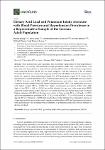Dietary Acid Load and Potassium Intake Associate with Blood Pressure and Hypertension Prevalence in a Representative Sample of the German Adult Population
Krupp, Danika
Esche, Jonas
Mensink, Gert
Klenow, Stefanie
Thamm, Michael
Remer, Thomas
Diets rich in fruits and vegetables, like the Dietary Approaches to Stop Hypertension (DASH)-diet, are usually characterized by high potassium intake and reduced dietary acid load, and have been shown to reduce blood pressure (BP). However, the relevance of potential renal acid load (PRAL) for BP has not been compared with the relevance to BP of urinary biomarker (K-urine)- and dietary food frequency questionnaire (K-FFQ)-based estimates of potassium intake in a general adult population sample. For 6788 participants (aged 18–79 years) of the representative German Health-Interview and Examination Survey for Adults (DEGS1), associations of PRAL, K-urine, and K-FFQ with BP and hypertension prevalence were cross-sectionally examined in multivariable linear and logistic regression models. PRAL was significantly associated with higher systolic BP (p = 0.0002) and higher hypertension prevalence (Odds ratio [OR] high vs. low PRAL = 1.45, p = 0.0004) in models adjusted for age, sex, body mass index (BMI), estimated sodium intake, kidney function, relevant medication, and further important covariates. Higher estimates of K-FFQ and K-urine were related to lower systolic BP (p = 0.04 and p < 0.0001) and lower hypertension prevalence (OR = 0.82, p = 0.04 and OR = 0.77, p = 0.02) as well as a lower diastolic BP (p = 0.03 and p = 0.0003). Our results show, for the first time in a comparative analysis of a large representative population sample, significant relationships of BP and hypertension prevalence with questionnaire- and biomarker-based estimates of potassium intake and with an estimate of dietary acid load.
No license information

